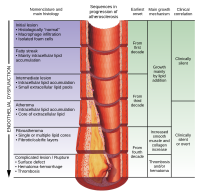
Photo from wikipedia
Simple Summary The clinical relevance of vascular calcifications has increased in recent years, given the aging of the population and increased exposure to risk factors. Tissue calcification is often a… Click to show full abstract
Simple Summary The clinical relevance of vascular calcifications has increased in recent years, given the aging of the population and increased exposure to risk factors. Tissue calcification is often a point of no return that leaves no room for any medical therapy and limits the possibility of surgical and interventional treatments—a real insurmountable barrier. The diffusion of cardiac imaging methods has made the recognition of cardiac calcifications, at various levels and of variable extent, more and more frequent. The pathogenesis of calcifications is not unique but includes different mechanisms, depending on the specific site and disease, which, in turn, results in different phenotypes. Unfortunately, however, clinicians are not always aware of these different mechanisms and phenotypes. This concise, but in-depth, review explores the different molecular processes and their links with the specific clinical condition, and current therapeutic approaches to counteract calcifications. Abstract There is a growing interest in arterial and heart valve calcifications, as these contribute to cardiovascular outcome, and are leading predictors of cardiovascular and kidney diseases. Cardiovascular calcifications are often considered as one disease, but, in effect, they represent multifaced disorders, occurring in different milieus and biological phenotypes, following different pathways. Herein, we explore each different molecular process, its relative link with the specific clinical condition, and the current therapeutic approaches to counteract calcifications. Thus, first, we explore the peculiarities between vascular and valvular calcium deposition, as this occurs in different tissues, responds differently to shear stress, has specific etiology and time courses to calcification. Then, we differentiate the mechanisms and pathways leading to hyperphosphatemic calcification, typical of the media layer of the vessel and mainly related to chronic kidney diseases, to those of inflammation, typical of the intima vascular calcification, which predominantly occur in atherosclerotic vascular diseases. Finally, we examine calcifications secondary to rheumatic valve disease or other bacterial lesions and those occurring in autoimmune diseases. The underlying clinical conditions of each of the biological calcification phenotypes and the specific opportunities of therapeutic intervention are also considered and discussed.
Journal Title: Biology
Year Published: 2022
Link to full text (if available)
Share on Social Media: Sign Up to like & get
recommendations!